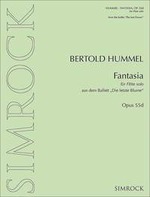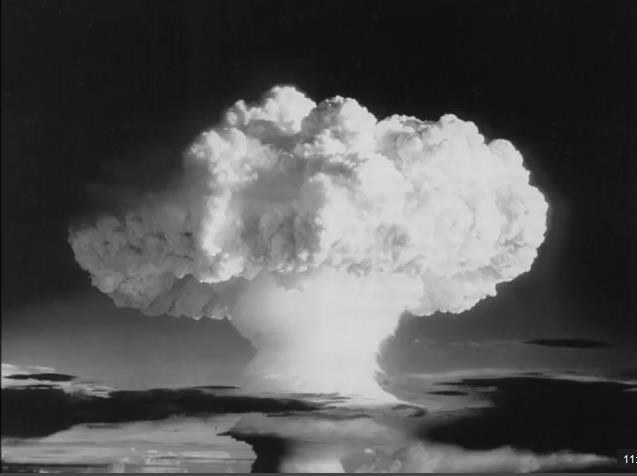
Duration:
5 Minutes
Publisher: N. Simrock Hamburg-London (Boosey & Hawkes) EE 2978 / ISMN: 9790221108968
see on youtube Fragment op. 55c
The Ballet, "The Last Flower", after J. Thurber, describes power, the misuse of power, war, destruction and hope in recurring succession. The flute solo represents the vain attempt of the "last flower" to spread hope, a hope which withers in the falling atomic rain.
Bertold Hummel
Preface (Corrected New Edition 2014)
Among flutists, the title of the ballet Die letzte Blume (The Last Flower) inevitably evokes associations with the song The Last Rose of Summer on which both Ludwig van Beethoven (op. 105, no. 4) and Friedrich Kuhlau (likewise op. 105) composed variations for flute and piano. The similarity of the titles is however deceptive: musically or in terms of content, The Last Flower and The Last Rose of Summer have nothing to do with one another.
The Last Flower by Bertold Hummel is based on the parable The Last Flower (1939) by James Thurber. In it, war and peace are depicted as two phases of a civilization-determined cycle that will one day lead to the complete destruction of life and love, if man does not learn from history. In this parable, the last flower is the symbol of nature without which humankind cannot survive. If the last flower dies, man also dies.
Hummel transports Thurber’s parable into the period of the 1970s in that he links them in his ballet The Last Flower, op. 55a, to the Cold War and the nuclear threat. After a devastating war, a “flower blossoms alone” in the desolation “and unfolds its full beauty. Since it is not noticed by anybody, it seeks to call attention to itself. In vain it attempts to draw into its spell the figures that are crouching on the ground as if petrified. Finally, it succeeds in attracting the attention of a young girl. Touched by the beauty of the flower, the girl’s senses are awakened, her will to live kindled, and her initial astonishment transformed into joy and enthusiasm (dance: Girl + Flower). Then she wants to convey her discovery to other people. After various attempts, she succeeds in bringing the flower to the attention of a young man. He, too, is touched by the beauty of the blossoming flower and feels a new lust for life. At the same time, love for the young girl awakens in him” (from Hummel’s synopsis of the plot). Out of this love of life, a civilization gradually develops again. But it leads once more to a war, to the last war. On the world destroyed by nuclear weapons, “the ‘last flower’ timidly blossoms yet again but, not finding any resonance, dies away” (from Hummel’s synopsis of the plot).
Hummel’s Fantasia op. 55d is made up of three parts of this ballet. The first section describes the first blossoming and search for attention (at m. 1 in the score: Dance of the Flower). In the ballet, this is a flute cadenza behind the stage. This is followed by the girl’s discovery of the flower (at m. 31 in the score: “The girl catches sight of the flower”). In the ballet version, a vibraphone joins the flute here. This second section of the Fantasia is shortened somewhat compared with the ballet. The third section (from m. 63) is taken from the end of the ballet, where – like the two other sections – it is played behind the stage. It depicts the final blossoming and death (at m. 83 in the score: “The flower is the last to die in the deadly nuclear rain”).
The ballet The Last Flower, op. 55a, was premiered on 4 May 1975 in the WŘrzburg Municipal Theater under the musical direction of Max Kink. The flute soloist on this evening was Hubert Scholtes. The Fantasia for flute solo from the ballet “The Last Flower,” op. 55d, was published in 1984 by Simrock, Hamburg. Unfortunately, important tempo markings are lacking in this first edition (source F). Moreover, the performance instructions are placed very carelessly and the music spacing in the measures is awkward, which was undoubtedly due to the use of a music typewriter for the engraving of the music. This made a new edition of this work necessary for reasons of content and aesthetics. The engraver‘s copy for the first edition is unfortunately unknown, but the autograph of the ballet version (source A) has been preserved. It is distinguished by good legibility and unambiguousness. Valuable information is also provided by the written-out flute part of the ballet version (source P).
The musical text of the present new edition follows source F in terms of musical substance (pitches and rhythm). For the expression marks (dynamics and tempo), on the other hand, source A was given preference as the authoritative source. The few expression marks missing in the autograph, but that are found in the first edition, have been taken over without comment. Editorial additions that go beyond this are set in square brackets [ ]. This also pertains to additions from source P.
Henrik Wiese
Munich, autumn 2013
Press
Tibia 1/1985
Bertold Hummel has taken two solo flute episodes, originally played behind the scenes in the ballet of the same name, and joined them together in a formally convincing way to one well-rounded piece. Although the musical material is definitely relates to the dramatic plot of the ballet, the Fantasia taken as an autonomous musical statement seems indeed to be significant and substantial. Listener, performer and reader will find they can discern the architecture of the piece in its easily identifiable patterns of intervals; they will notice how, towards the end, the circle gradually closes; they will not miss the inversion of the intervals - which mark clearly the formal sections - of characteristic rhythmic-melodic figures; an espressivo cantilena will not escape their attention. One could mention other details of this kind; summing up, the great virtue of the piece is its clarity or "Fa▀lichkeit", ("graspability"), as it was called in the Vienna School, without losing as a result any degree of originality, spontaneity or genuine emotionality.
Heino Schwarting
Musical Times, May, 1986
Bertold Hummel's Fantasia op. 55d from the Ballet "The Last Flower" is a lively and well written piece, uses flourishes, trills and runs in unorthodox ways and could test the players to the limits of their abilities.

